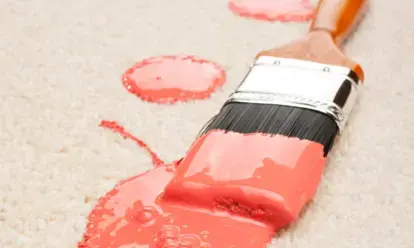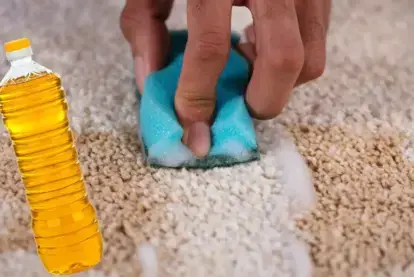
How to Get Dried Paint Out of Your Carpet
Contact COIT for a professional cleaning!
A paint spill on your carpet can turn a quick project into a frustrating mess. Whether it’s water-based or oil-based paint, the key is knowing how to treat it—especially once it dries.
In this guide, we’ll show you exactly how to get dried paint out of carpet using simple tools, step-by-step instructions, and expert-backed tips that actually work.
How to Get Dried Paint Out of Carpet
To get dried paint out of carpet, gently scrape away any hardened paint with a dull knife, then soften the residue with warm water or WD-40. Blot the area with a cloth soaked in dish soap or rubbing alcohol, rinse with clean water, blot dry, and vacuum to restore the texture.
Steps to Remove Dried Paint From Carpet:
- Scrape off dried paint with a dull knife or spoon.
- Soften the residue with warm water, WD-40, or vinegar.
- Blot the stain using a cloth dipped in dish soap or rubbing alcohol.
- Rinse with clean water and blot dry.
- Vacuum the area to restore the carpet’s texture.
Different types of paint require different removal methods—especially once they’ve dried. Below, we’ll walk you through how to identify what kind of paint you’re dealing with, how to remove it safely, and when to call in COIT’s professional cleaning team to tackle the toughest carpet stains.
Understanding the Type of Paint Stain
Water-Based Paint Stains
Water-based paints, also known as latex or acrylic paints, are commonly used in both indoor and outdoor home DIY projects. This is due to their quick drying times and easy cleanup with water. Common examples of these paints include wall paint, craft paint, and exterior house paint.
Handling water-based paint on carpet involves understanding its unique characteristics. When wet, water-based paint has a thinner consistency and a lighter, less pungent odor than its oil-based counterpart. Its color may appear slightly lighter than when dry. Checking the paint can for clean-up instructions can also give you a clue, as water-based paints typically recommend water and soap for clean-up.
However, dealing with dried water-based paint on carpet can be slightly more challenging. The water in the paint evaporates as it dries, causing the paint to harden. Yet, with patience and the right techniques, these dried stains can be effectively removed.
Oil-Based Paint Stains
Oil-based paints, appreciated for their durability and smooth, glossy finish, are typically used in high-traffic areas and on surfaces that require a robust finish. These can include kitchen cabinets, trim, moldings, and outdoor furniture. Oil-based paint includes enamels, varnishes, lacquers, and stains.
These paints have a thicker consistency and a more robust, often described as 'chemical', smell. The color when wet will be very similar, if not identical, to the color when dry. Oil-based paints often require mineral spirits or paint thinner for clean-up, which will be indicated on the can.
Cleaning oil paint off carpet can be quite a task due to its strong adhesive properties and resistance to water. But with the right solvents and approach, both fresh and dried oil paint stains can be tackled effectively.
Call the PROs at COIT for a professional clean!
Tools and Materials Needed to Remove Paint Stains
Before diving into our carpet stain solutions, gather the necessary tools and materials:
- A spoon or dull knife
- Clean, white cloths or towels
- Mild dish soap
- Warm water
- Rubbing alcohol
- WD-40 or a similar lubricant
- A commercial paint remover
- A vacuum cleaner
Your choice of effective paint removers will depend on the type of paint you're dealing with, as we'll discuss below.
How to Remove Dried Paint Stains
Dried Water-Based Paint Stains
- Scrape Off the Paint: Use a dull knife to gently scrape off as much dried paint as possible.
- Apply Hot Water: Pour a small amount of hot water onto the stain to soften it.
- Apply Dish Soap: Add a few drops of dish soap to the stain and gently blot it with a clean cloth.
- Rinse and Dry: Once the stain lifts, rinse the area with warm water, blot it dry, and vacuum.
Dried Oil-Based Paint Stains
- Apply a Lubricant: WD-40 or a similar lubricant can be used to soften the dried paint.
- Blot the Stain: After allowing the lubricant to work for a few minutes, gently blot the stain with a clean cloth.
- Apply Rubbing Alcohol: If the stain persists, use a cloth to apply a small amount of rubbing alcohol.
- Rinse and Dry: Once the stain is removed, rinse with warm water, dry thoroughly, and vacuum.
How to Remove Wet Paint Stains
Fresh Water-Based Paint Stains
- Blot, Don't Rub: Use a clean, dry cloth to blot the spill. Rubbing could push the paint deeper into the carpet fibers.
- Create a Cleaning Solution: Mix a teaspoon of dish soap with a cup of warm water.
- Apply the Solution: Using a clean cloth, gently dab the solution onto the stain. Continue blotting until the stain lifts.
- Rinse and Dry: Rinse the area with warm water and dry it thoroughly using a clean towel. Once dry, vacuum to restore the carpet's texture.
Fresh Oil-Based Paint Stains
- Remove Excess Paint: Use a spoon or a dull knife to scrape off as much paint as possible.
- Apply a Solvent: Apply a small amount of rubbing alcohol or a commercial paint remover onto the stain using a clean cloth.
- Blot the Stain: Gently blot the stain, starting from the edges and working your way to the center.
- Rinse and Dry: Rinse the treated area with warm water, blot it dry, and vacuum.
Contact COIT for a professional cleaning!
Tips and Tricks for Successful Paint Stain Removal
Test Cleaning Solution to Avoid Damage
It’s important to always test any cleaning solution or solvent on an inconspicuous part of the carpet to avoid discoloration or damage. Carpet materials can react differently to various cleaning solutions, and some can cause discoloration or even fiber damage. Before applying a cleaning solution or solvent to the stained area, test it on a hidden part of the carpet, such as under furniture or in a closet. Allow it to sit for a few minutes, then blot it up. If there's no change in color or texture, it's safe to use on the stain.
Never Rub a Paint Stain
Remember to never rub a paint stain, as this can push it deeper into the carpet fibers. When dealing with paint stains, your instinct might be to rub or scrub the stain, but this can actually cause the paint to penetrate deeper into the carpet fibers, making it more difficult to remove. Instead, always blot or dab at the stain. This method lifts the stain away from the fibers rather than pushing it in.
Blot from Edges Toward Center
Always blot from the edges of the stain towards the center to prevent spreading. When blotting a paint stain, start from the outer edges and work your way towards the center. This technique prevents the stain from spreading further across the carpet. By working inwards, you contain the stain and prevent it from becoming larger.
Take Safety Measures Before You Begin
Safely use paint thinners or other harsh chemicals by wearing gloves and ensuring proper ventilation. Some paint stains, especially those from oil-based paints, might require the use of harsh chemicals or paint thinners. These substances can be harmful if they come into contact with skin or if their fumes are inhaled. Always use gloves when handling these chemicals and ensure your work area is well ventilated. If possible, use a respirator mask for added protection.
How To Avoid Paint Stains
Preventative measures to avoid future paint stains:
Cover Your Carpet Before Painting
Prevention is the best method of stain removal, and that starts with taking precautions before you even open the paint can. Cover your carpet with drop cloths, plastic sheeting, or old sheets to protect it from potential spills or splatters. Ensure the coverings are secured so they don't shift during the painting process, exposing the carpet to possible accidents.
Keep a Damp Rag Nearby
A damp cloth can be your first line of defense against fresh paint stains. If a spill or splatter occurs, immediately blotting the area with a damp cloth can prevent the paint from setting into the carpet fibers. Remember, time is crucial when dealing with paint spills, so having a cloth on hand saves you valuable time.
Use a Paint Can Lid or Paint Tray
Instead of painting directly from the can, use a paint can lid or paint tray to limit the possibility of large spills. These tools help control the amount of paint on your brush or roller and provide a secure place to set your painting tools, reducing the risk of accidentally knocking over the paint can.
When to Call a Professional
Despite the most diligent DIY attempts, some paint stains might still persist, proving too stubborn or extensive for home methods. If the stain persists after multiple attempts or is too large or deep, professional carpet cleaning may be necessary.
Professionals have expert knowledge, access to specialized cleaning equipment, and the ability to effectively treat various carpet materials, making them well-equipped to handle stubborn paint stains without damaging the carpet. Even if you're just looking to some save time and effort, COIT’s expertly trained technicians can provide peace of mind that the job is done correctly and efficiently.
Contact COIT for a professional cleaning!
FAQs: Dried Paint & Carpet
Can I use vinegar to remove dried paint from carpet?
Yes, vinegar can help soften dried latex or acrylic paint. Pour a small amount on the stain, let it sit for 5–10 minutes, and then blot with a clean cloth. Avoid using vinegar on wool or delicate carpets without testing first.
Will nail polish remover get dried paint out of carpet?
It can—but be cautious. Acetone (in nail polish remover) might damage certain carpet fibers or backing. Use it only on synthetic carpets, and always test in an inconspicuous area.
What’s the best way to get latex paint out of carpet after it dries
Scrape off what you can, then soften with warm water or vinegar. Use a mix of dish soap and water or rubbing alcohol to blot the stain out gently.
How do I remove dried paint that’s been there for weeks?
Use WD-40 or a solvent like rubbing alcohol to soften and lift old paint. Patience and repeated applications may be needed for set-in stains.
Will paint thinner ruin my carpet?
Paint thinner can damage carpet fibers and backing if used improperly. Use a small amount and test in a hidden area first. Only use on oil-based paint stains.



